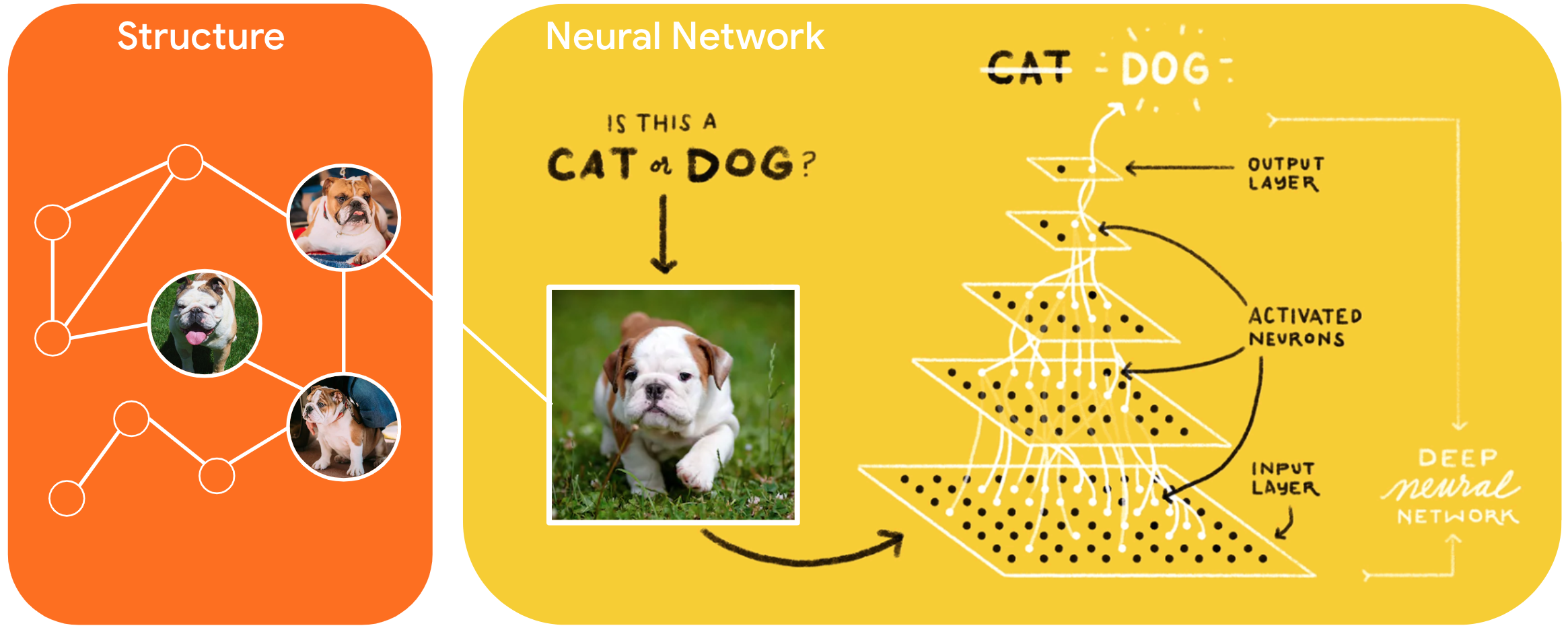tensorflow / Neural Structured Learning
Programming Languages
Projects that are alternatives of or similar to Neural Structured Learning
Neural Structured Learning in TensorFlow
Neural Structured Learning (NSL) is a new learning paradigm to train neural networks by leveraging structured signals in addition to feature inputs. Structure can be explicit as represented by a graph [1,2,5] or implicit as induced by adversarial perturbation [3,4].
Structured signals are commonly used to represent relations or similarity among samples that may be labeled or unlabeled. Leveraging these signals during neural network training harnesses both labeled and unlabeled data, which can improve model accuracy, particularly when the amount of labeled data is relatively small. Additionally, models trained with samples that are generated by adversarial perturbation have been shown to be robust against malicious attacks, which are designed to mislead a model's prediction or classification.
NSL generalizes to Neural Graph Learning [1] as well as to Adversarial Learning [3]. The NSL framework in TensorFlow provides the following easy-to-use APIs and tools for developers to train models with structured signals:
-
Keras APIs to enable training with graphs (explicit structure) and adversarial perturbations (implicit structure).
-
TF ops and functions to enable training with structure when using lower-level TensorFlow APIs
-
Tools to build graphs and construct graph inputs for training
The NSL framework is designed to be flexible and can be used to train any kind of neural network. For example, feed-forward, convolution, and recurrent neural networks can all be trained using the NSL framework. In addition to supervised and semi-supervised learning (a low amount of supervision), NSL can in theory be generalized to unsupervised learning. Incorporating structured signals is done only during training, so the performance of the serving/inference workflow remains unchanged. Please check out our tutorials for a practical introduction to NSL.
Getting started
You can install the prebuilt NSL pip package by running:
pip install neural-structured-learning
For more detailed instructions on how to install NSL as a package or to build it from source in various environments, please see the installation guide
Note that NSL requires a TensorFlow version of 1.15 or higher. NSL also supports TensorFlow 2.x with the exception of v2.1, which contains a bug that is incompatible with NSL.
Videos and Colab Tutorials
Get a jump-start on NSL by watching our video series on YouTube! It gives a complete overview of the framework as well as discusses several aspects of learning with structured signals.
We've also created the following hands-on colab-based tutorials that will allow you to interactively explore NSL:
Contributing to NSL
Contributions are welcome and highly appreciated - there are several ways to contribute to TF Neural Structured Learning:
-
Case studies. If you are interested in applying NSL, consider wrapping up your usage as a tutorial, a new dataset, or an example model that others could use for experiments and/or development.
-
Product excellence. If you are interested in improving NSL's product excellence and developer experience, the best way is to clone this repo, make changes directly on the implementation in your local repo, and then send us pull request to integrate your changes.
-
New algorithms. If you are interested in developing new algorithms for NSL, the best way is to study the implementations of NSL libraries, and to think of extensions to the existing implementation (or alternative approaches). If you have a proposal for a new algorithm, we recommend starting by staging your project in the
researchdirectory and including a colab notebook to showcase the new features.If you develop new algorithms in your own repository, we are happy to feature pointers to academic publications and/or repositories that use NSL, on tensorflow.org/neural_structured_learning.
Please be sure to review the contribution guidelines.
Research
See our research directory for research projects in Neural Structured Learning:
- Low-Dimensional Hyperbolic Knowledge Graph Embeddings
- A2N: Attending to Neighbors for Knowledge Graph Inference
- GAM: Graph Agreement Models for Semi-Supervised Learning
- Neural Clustering Processes
Issues, Questions, and Feedback
Please use GitHub issues to file issues, bugs, and feature requests. For questions, please direct them to Stack Overflow with the "nsl" tag. For feedback, please fill this form; we would love to hear from you.
Release Notes
Please see the release notes for detailed version updates.





